Invasive Species: Ranunculus ficaria, Fig Buttercup
Fig buttercup is a short (up to 12 in. [30.5 cm]), herbaceous perennial that invades forests throughout the East, Midwest and Pacific Northwest regions of the United States. The basal leaves are dark green, shiny, kidney- to heart-shaped, and vary greatly in size. Flowering occurs in March and April, when showy, bright yellow, eight-petaled flowers develop on stalks above the leaves. Flowers are up to 3 in. (7.6 cm) wide. The fruit are achenes that are pubescent. It also reproduces with bulblets and tubers. Fig buttercup invades moist, forested floodplains. It is a spring ephemeral and grows vigorously, creating dense mats that exclude all other vegetation. Fig buttercup is a threat particularly to the native forest spring ephemerals that have to compete for light and space with this invasive. The plant is native to Europe and was first introduced into the United States as an ornamental. It is currently sold and widely planted as an ornamental.
What are invasive species and why should we be concerned about them?
Taxonomy: Scientific and Common Names for This Species
Ranunculales > Ranunculaceae > Ranunculus ficaria L.
Synonym(s): lesser celandine
Ranunculus ficaria – USDA PLANTS Profile
Distribution Maps
Fig buttercup – The reported distribution of this invasive species across the United States (Source: Invasive Plant Atlas of the United States)
Up-to-the-minute distribution maps and why they are important
Reporting This Invasive Species
What is the best way and place to report the occurrence of an invasive species?
How to report an invasive species sighting to EDDMapS – Early Detection & Distribution Mapping System
EDDMapS – Report an invasive species to EDDMapS.
Cooperative Extension Offices – Find your local Cooperative Extension office on this map provided by USDA.
How to Identify
This invasive species can be identified by looking for the characteristics described in the paragraphs that follow.
Plant
Fig buttercup is a short (up to 12 in. [30.5 cm]), herbaceous perennial.
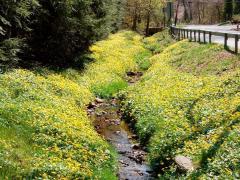 |
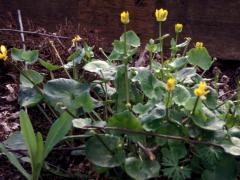 |
| John M. Randall, The Nature Conservancy, bugwood.org | John M. Randall, The Nature Conservancy, bugwood.org |
Foliage
The basal leaves are dark green, shiny, kidney- to heart-shaped, and vary greatly in size.
 |
 |
| Leslie J. Mehrhoff, University of Connecticut, bugwood.org | John M. Randall, The Nature Conservancy, bugwood.org |
Flower
Flowering occurs in March and April, when showy, bright yellow, eight-petaled flowers develop on stalks above the leaves. Flowers are up to 3 in. (7.6 cm) wide.
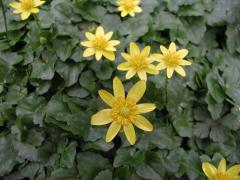 |
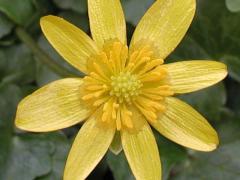 |
| Leslie J. Mehrhoff, University of Connecticut, bugwood.org | Leslie J. Mehrhoff, University of Connecticut, bugwood.org |
Fruit
The fruit are achenes that are pubescent. Fig buttercup also reproduces with bulblets and tubers.
 |
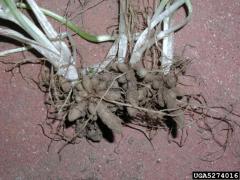 |
| Leslie J. Mehrhoff, University of Connecticut, bugwood.org | Leslie J. Mehrhoff, University of Connecticut, bugwood.org |
Native Species That Can Resemble Fig Buttercup
Caltha palustris, yellow marsh marigold – Images at invasive.org
 |
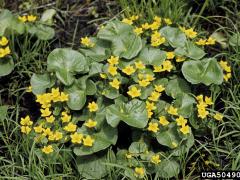 |
| Joseph O’Brien, USDA Forest Service, bugwood.org | Joseph O’Brien, USDA Forest Service, bugwood.org |
– Images at invasive.org
| bugwood.org | bugwood.org |
Additional Images for Fig Buttercup
Fig buttercup – Images at Invasive.org
Learning Resources for Fig Buttercup
Additional Information, Biology, Control and Management Resources
Control and management recommendations vary according to individual circumstances. Location, habitat, weather, and a variety of other conditions are factors that help determine the best treatment choice. To find the safest and most effective treatment for your situation, consult your state’s land-grant institution. If you will use chemicals as part of the control process, always refer to the product label.
United States Land-Grant University System – Find your land-grant university’s college of agriculture, Cooperative Extension office, or other related partner on this map provided by USDA.
Fact Sheet – Pennsylvania Dept. of Conservation and Natural Resources
Plant Invaders of Mid-Atlantic Natural Areas – National Park Service and US Fish & Wildlife Service
Weeds Gone Wild: Alien Plant Invaders of Natural Areas – Plant Conservation Alliance
Invasive Plant Atlas of New England – University of Connecticut
Weed of the Week – USDA Forest Service
